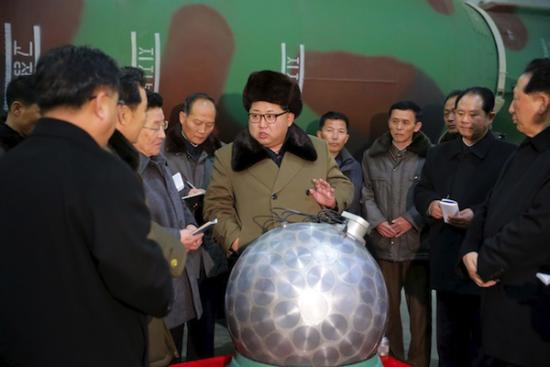[美 Time 誌] 북한을 공격해야 할 싯점인가?
페이지 정보
작성자본문
미국은 그 동안 벼르고 있었고, 이제 그 타격에 합당한 종심적 從心的 명분의 구실을
분노조절 장애자, 성격파탄자, 정신분열증 환자인 정은이가 친절하게 제공하였다
남녘의 그 누군, 미국의 지시를 받은대로 충직하게 개성공단 전격폐쇄 등 둘러리를 서주고..
유사시 해외도피도 확실히 보장받았을 것이다
(개인적 생각으로) 미국은 차제 此際에 도야지의 목을 따려고 확고히 작심한 거 같다
일본은 한반도 재침탈을 위한 일본군 진주 進駐의 절호의 기회로 삼을 것이고
이로 인해, 발생되는 한반도 內 인명피해 같은 건 일체 신경 쓰지 않는다
- 어차피 미국이나 일본, 지네들 본토에서 벌어지는 전쟁도 아니기에
한반도 전선에서 죽어갈, 애먼 수 많은 남북의 병사들은 그렇다치고..
남북의 민간인들은 모두, 각자도생 各自圖生을 기할 수밖에 없을듯 하다 (냉엄한 현실)
이 엄중한 시기에 모리배 정치꾼들은 여야 막론, 밥그릇(공천) 싸움에 이전투구 泥田鬪狗다
죽어나갈 국민들만 불쌍하다
* 이 모든 불길한 예상이 빗나가길, 천지신명께 간절히 바라며..
=========================================================
타임誌, 2016년 3월 10일
북한을 공격해야 할 싯점인가?
Is It Time to Attack North Korea?
http://time.com/4252372/north-korea-nuclear-missile-attack/

내용이 길어서 제가 다는 번역을 못하겠고 핵심만 줄이면..
어제 평양은 핵탄두를 소형화 해서 미국에 대한 핵공격에 한발 더 다가섰다고 밝혔다.
- 중략 -
북한의 변치않는 대륙간탄도 핵미사일 개발과,
은둔왕국을 지배하는 괴이한 광신도적 독재 세습 왕조,
굶주리는 수 백만, 정치범 수용소에 갇힌 수 십만을 고려할 때에 명백한 질문은 간단하다.
"평양의 핵 협박을 무력으로 제거하기 위해 미국이 리더로 나서야 하는가?"
미국의 군 관계자들이 말하기를
"북한의 두 군데 핵 주요시설을 파괴하는 것은 아마 위험하겠지만 그렇게 어려운 일은 아니다"
"단 북한의 보복 공격으로 35마일 떨어진 수도 서울의 1000만이 문제가 될 것이다" 라고 인정했다.
그러나 북한의 핵무기가 더 진보할 수록 평화적으로 해체하기란 더욱 어려워질 것이다
미국과 세계가 북한의 핵 진보를 막는데 실패했다.
22년전 국방장관 윌리엄 페리가 타임지와의 인터뷰에서 말하기를,
"우리는 북한이 괄목할만한 핵무기를 보유하지 못하도록 정책을 써왔다" 고 했다.
그러나 지금 그 정책은 실패했다.
2006년에는 페리와 현재 국방장관인 애쉬턴 카터가 북한 미사일이 미국으로 발사되기 전에
폭격해야 한다고 주장했다.
그때 미국은 폭격하지 않았고 북한의 미사일 발사는 실패했다.
그러나 장차 언젠가 미국이 항상 운이 좋을 수만은 없을 것이다.
(개발하도록 그냥 놔두면 장차 북한 핵미사일이 미국으로 날라들 수도 있다는 뜻,
그렇게 되기 전에 공격해야 한다는 뜻으로 해석된다)
Pyongyang’s claim that it has shrunk a nuclear warhead brings it one step closer to striking the U.S.
North Korea has been saying for years that it is striving to build a nuclear-tipped missile capable of attacking the U.S. It took a giant step toward that prize Wednesday when its official news agency asserted the nation’s scientists had miniaturized an atomic warhead capable of riding atop a Pacific-spanning rocket.
North Korean media showed leader Kim Jong-un standing before a beach ball-sized silver sphere purportedly representing a shrunken warhead. South Korea declared North Korea’s claim an “intolerable direct challenge” to the world.
“The right to make a preemptive nuclear strike is by no means a monopoly of the U.S.,” the Korean Central News Agency said, paraphrasing Kim during his visit with North Korean engineers working on the project. “If the U.S. imperialists infringe upon the Democratic People’s Republic of Korea’s sovereignty and right to existence with nuclear weapons, it will never hesitate to make a preemptive nuclear strike at them.” Given North Korean secrecy, the claim is impossible to verify.
But in light of North Korea’s inexorable push to develop a nuclear-carrying intercontinental ballistic missile—and the bizarre cult-of-personality dynasty that runs the Hermit Kingdom, starving millions and jailing thousands of political prisoners—the obvious question is simple: should the U.S. take the lead in taking down Pyongyang’s nuclear menace by force?
Nuclear experts have been saying for years that North Korea might be able to shrink a nuclear warhead. That’s critical, because a smaller warhead translates into longer range. The non-profit Institute for Science and International Security said in 2013 that North Korea still would need “to conduct missile flight tests with a re-entry vehicle and mock warhead, increase the explosive yield of the warhead, possibly requiring its further miniaturization, and improve the operational reliability of the warhead and missile” to be sure its missile would work.
While that may be the path followed by most nations, North Korea is hardly a normal country. Corner-cutting, especially if the nation perceives itself as threatened, could accelerate that process. With the U.S. and South Korea now conducting a huge military exercise, and new sanctions recently imposed on North Korea, it’s no wonder that Pyongyang is feeling beleaguered. Only hours after North Korea announced its alleged miniaturization breakthrough, a U.S. artillery brigade launched a barrage of rockets close to the border town of Cheorwon, something bound to jangle North Korean nerves even more.
The U.S. has built a missile shield in Alaska and California dedicated to the threat posed by North Korean rockets. The Pentagon voiced confidence Tuesday in its ability to down any incoming North Korean warheads. “The United States has not seen North Korea demonstrate a capability to miniaturize a warhead,” Pentagon spokesman Peter Cook said shortly before the North Korean claim that it had done so. “We still feel confident that we can deter and respond to a missile threat from North Korea.”
Taking out North Korea’s two major nuclear sites with air strikes would be dangerous but probably not too difficult, U.S. officials say. The possibility of North Korean retaliation against Seoul, South Korea’s capital of 10 million and only 35 miles from North Korea, would be a complicating factor, they concede.
Yet the more advanced North Korea’s nuclear arsenal becomes, the tougher it will be to dismantle peacefully. Its slow but steady progress on the nuclear front is something that the U.S. and the rest of the world has been unable to stop. “Our policy right along,” Defense Secretary William Perry told TIME in his flying stateroom over the Atlantic 22 years ago, “has been oriented to try to keep North Korea from getting a significant nuclear-weapon capability.”
That effort has failed. In fact, in 2006, Perry and Ashton Carter—the current defense secretary—argued that the U.S. should attack a North Korean missile before it could be launched.
The U.S. didn’t attack, and the missile test failed. Somewhere down the road, Americans might not be so lucky.
댓글목록
등록된 댓글이 없습니다.





